How to Notch a Tree for Safe & Proper Felling
Author: Chris Miller | Editor: Omar Alonso
Review & Research: Jen Worst & Chris Miller
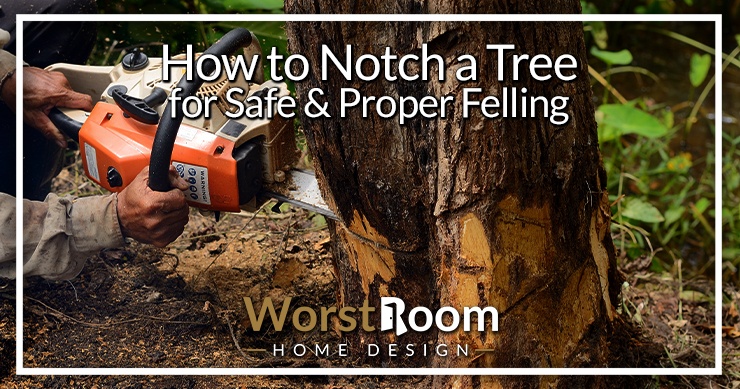
Do you have a tree in your yard looming menacingly over your home? One strong wind storm and the tree might fall over onto the roof, causing thousands in property damage. It's time to learn how to notch a tree to fall and fell it tree before that nightmare comes true.
You can't just take the chainsaw to the tree trunk and start sawing away to fell the tree. YouTube has hundreds of videos where homeowners make this mistake, causing the tree to fall on their homes. You'll need to notch the trunk to ensure the tree falls away from your house.
This guide gives you a step-by-step method to notching the trunk for safe felling of the tree.
Why Do You Notch a Tree to Fell It?
Notching the tree helps you control the direction in which the tree falls. Without notching the tree, its natural lean or the weight of the branches could turn it in the wrong direction as it falls. The result is the tree crashing through your home's roof, boundary walls, or maybe even the neighbor's property, costing you tens of thousands in repairs.
Worse yet, your homeowner's insurance might not cover the cost of repairs. Notching the tree gives you the foundation for safe felling, lowering the risk of something going wrong. The side to make the notch is the side to which the tree falls. It's essential to complete this step in any DIY tree-felling job. Let's run through the steps to successfully notching a tree.
How to Notch a Tree to Fall – A Step-by-Step Guide
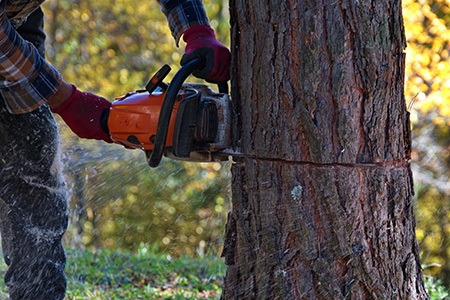
Please read these instructions in their entirety before you begin so you don’t encounter any surprises, especially since the safety of your home and your self is involved.
1) Gather Your Tools & Materials
To start, gather your tools and safety gear. We recommend using the following Personal Protective Equipment (PPE):
- Steel toe boots
- Pants and long sleeves
- Heavy work gloves
- Safety goggles
- Hearing protection
- Hard hat (branches and will fall)
Next, gather your tools for the job:
- Gas-powered Chainsaw (Ensure it's well-maintained & fueled)
- Ladder & Rope
- Felling wedges
Please don’t skip out on any safety measures, no matter how experienced you are or how low the risk feels to you. It’s always the “freak accidents” that you can’t predict that cause harm. It’s when you think you can get away without it that you really need it.
2) Find an Assistant or Assistants
Felling a tree, especially large trees, isn't a job to undertake by yourself. The tree's weight and the propensity for danger mean you'll need an assistant to support you during the task and someone to call for help if things go wrong.
If you have no experience felling trees, it's a good idea to call a professional service to handle the job or monitor you while you do it.
3) Examine the Structure of the Tree
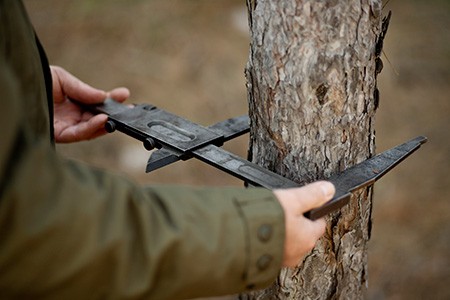
Take a close look at the tree before you start the job. Examine the branches to see if they make one side of the tree heavier. Look at the height of the tree – could it cause damage to surrounding areas like walls or the neighbor's property when it falls? If so, you must remove the heavier branches or top the tree before felling it.
4) Clear the Area Where the Tree Will Fall
Clear all vehicles, tools, people, and pets from the felling area and the expected landing site where you want the tree to fall.
5) Examine the Tree's Lean
If the tree stands straight, felling is an easy task. Felling a leaning tree is a more challenging task. You'll need to take special care when felling a tree against or with the lean.
6) Use the Chainsaw to Create a Flat Cut
Make sure you're blade is sharp and you've not sharpened the chainsaw chain too many times, which can lead to failure of the chain and overdrawing power from the tool in general.
Start to cut the notch by making a flat cut with a sufficiently powerful and long type of chainsaw. Start the flat cut at waist or knee height and make it parallel to the ground. Take your time to get it right, as it's critical in how to notch a tree to fall correctly.
Cut one-third to one-quarter of the way through the trunk. Remember, the tree will fall to the side of the notch, so position it in the direction you want it to fall. Stop after making the flat cut.
7) Make the Angled Cut
Select a spot a couple of inches above the flat cut and cut downwards at a 45-degree angle to line up with the rear of the flat cut. Ensure the angled and flat cuts meet precisely. Cutting the angle too shallow results in an ineffective notch, and the tree might fall in a direction you don't expect.
8) Free the Notch
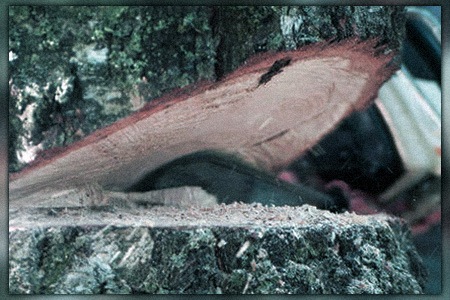
After making the flat and angled cut, remove the notch. It should come away freely. If it feels stuck, you've likely gone too deep, and the tree's weight is pressing down on it.
If that's the case, stop the job and call a professional to finish it for you. Continuing the job, in this case, might put your life, family, and property at risk, so don't attempt to go any further.
However, you're on the right track if the notch comes away freely. If a small piece of wood at the rear of the cuts prevents the notch from coming loose, deepen the cuts slowly until they meet. Or knock out the notch using an axe or sledgehammer.
After removing the notch, you're ready to start felling.
9) Saw the Felling Cut Opposite the Notch
To fell the tree:
- Make the felling cut on the opposite side of the notch.
- Start your cut 2 inches above the base of the notch.
- Cut from the back of the tree towards the notch, but stop a few inches short of the notch.
Cutting all the way through results in an unpredictable and dangerous fall.
If you've notched the tree properly and done the felling cut the right way, follow these tips for safe felling.
- Stand off to the side of the tree when you're ready to fell it.
- Don't stand directly behind or in front of it.
- Don't stand on the notched side, or you risk the tree falling on you, resulting in a life-threatening injury.
- Standing on the side of the felling cut may also cause a nasty injury as the trunk kicks back when the tree crashes to the ground.
- The tree should fall on its own after making the felling cut.
Be careful when people tell you that they want to attach a chain to the tree and pull it with their vehicle and other dangerous ideas. This can lead to the tree landing on the occupied vehicle. Don’t do this.
After this, you need to decide if you're going to grind out the tree stump, kill the tree stump over time, or even hollow out the tree stump to use in other ways such as a form of a garden.
FAQ’s Regarding Notching a Tree
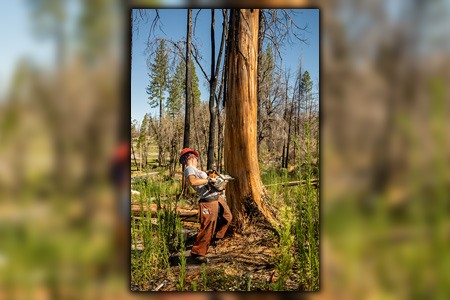
There’s always more questions related to the process of how to notch a tree to fall. Let’s dig into the most common question here.
How Big Do You Make a Notch in a Tree Before Felling It?
The notch must never be deeper than one-third of the trunk's diameter. If you cut it too deep, the tree might fall unexpectedly, causing severe injury to you or your family and damaging your property.
A professional arborist typically cuts a felling notch 1/4 or 1/3 the trunks diameter for safe felling, depending on the size of the tree. Don't assume you have to go to 1/3 depth for successful felling. A 1/4 of the diameter is usually all it takes for successful felling.
What Shape Do I Make the Notch in the Tree Before Felling It?
The ideal shape for a felling notch is triangular. However, remember to keep the base cut flat. Don't make the angular cut below the flat cut; always cut it above. Cutting the angle below the flat results in an unexpected fall.
Remember to make the flat cut around ankle to waist height from the ground. Start the angular cut a few inches above the felling cut, but don't make it too shallow. Ideally, it should form a triangle with a 45-degree angle for the best results with the felling.
Which Way Will the Tree Fall When I Cut it After Notching It?
The tree falls to the side of the notch if you do it correctly. If you can't remove the notch after making the triangular cut, it could be due to cutting too deep, resulting in the weight of the tree pressing on the notch. Or it could be that you didn't connect the angular and flat cut correctly. If that's the case, knock the notch pout with the back of an axe or a sledgehammer to free it.
Key Takeaways on Notching a Tree
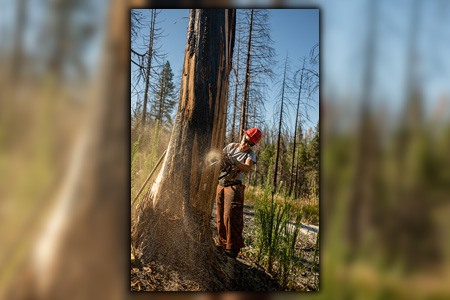
Let’s recap the main points above regarding how to notch a tree:
- Felling a tree is a dangerous job and shouldn't be undertaken by individuals with no felling experience or no experience using a chainsaw.
- Before making the felling cut, you'll need a good sense of structural dynamics to understand how the tree will fall.
- If you don't have either of these skills, call a professional arborist to handle the felling job.
- Examine the tree before felling and note it's lean. You'll need to take special care with the felling job if it's leaning.
- Look at the branches and think about where they will fall and how they'll influence the direction of the fall. If the branches are big, you'll have to use your ladder and rope to remove them before starting the notch cut.
- Don't cut any further than 1/3 of the way into the trunk's diameter, or you create dangerous conditions ideal for an unpredictable fall. Professionals usually don't go any further than ¼ of the diameter into the trunk. Deeper isn't always better.
- Start the felling cut on the opposite side of the trunk from the notch.
- Stand to the side of the tree, not in front of the notch or the felling cut.
Remember to have an assistant nearby. They serve as a lookout and an emergency contact if there's an accident when felling the tree. If you're felling but not cutting up and hauling off, consider the cheapest time of year for tree removal before you get started.
How to Notch a Tree for a Controlled Timber Drop
Let me stress that if you're at all concerned about how to pull this off correctly, just hire a professional. Even letting them drop one tree while you observe the process (and let them know this is your intention so that you can fell the other ones on your own) will teach you how it's done.
Let them handle the ones closest to your home, garage, power lines, etc. Then you can be left with the ones where it won't matter that much if it doesn't fall in the exact direction you planned. Just don't let them hit a paved road or anything like that. Follow our guide above for how to notch a tree even as you learn the process from a pro so you can help solidify the knowledge.



